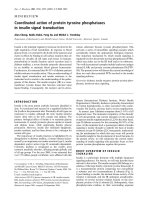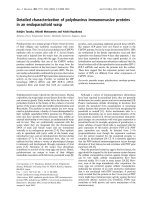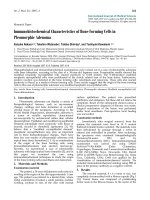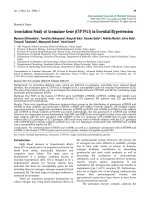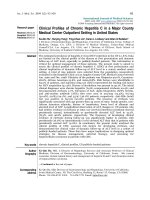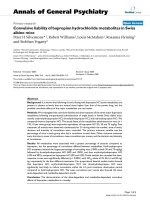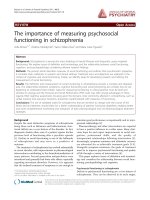Báo cáo y học: "Prognostic value of brain natriuretic peptide in acute pulmonary embolism" docx
Bạn đang xem bản rút gọn của tài liệu. Xem và tải ngay bản đầy đủ của tài liệu tại đây (506.75 KB, 7 trang )
Open Access
Available online />Page 1 of 7
(page number not for citation purposes)
Vol 12 No 4
Research
Prognostic value of brain natriuretic peptide in acute pulmonary
embolism
Guillaume Coutance
1
, Olivier Le Page
2
, Ted Lo
1
and Martial Hamon
1,3
1
Service des Maladies du Coeur et des Vaisseaux, UF Soins Intensifs Cardiologiques, Centre Hospitalier Universitaire de Caen, Avenue Côte de
Nacre, 14033 Caen Cedex, Normandy, France
2
Service de Chirurgie Cardiaque, Centre Hospitalier Universitaire de Caen, Avenue Côte de Nacre, 14033 Caen Cedex, Normandy, France
3
Inserm 744, Institut Pasteur de Lille, 1 rue du Professeur Calmette, 59019 Lille cedex, France
Corresponding author: Martial Hamon,
Received: 10 Jun 2008 Revisions requested: 8 Jul 2008 Revisions received: 6 Aug 2008 Accepted: 22 Aug 2008 Published: 22 Aug 2008
Critical Care 2008, 12:R109 (doi:10.1186/cc6996)
This article is online at: />© 2008 Coutance et al.; licensee BioMed Central Ltd.
This is an open access article distributed under the terms of the Creative Commons Attribution License ( />),
which permits unrestricted use, distribution, and reproduction in any medium, provided the original work is properly cited.
Abstract
Introduction The relationship between brain natriuretic peptide
(BNP) increase in acute pulmonary embolism (PE) and the
increase in mortality and morbidity has frequently been
suggested in small studies but its global prognostic
performance remains largely undefined. We performed a
systematic review and meta-analysis of data to examine the
prognostic value of elevated BNP for short-term all-cause
mortality and serious adverse events.
Methods The authors reviewed PubMed, BioMed Central, and
the Cochrane database and conducted a manual review of
article bibliographies. Using a prespecified search strategy, we
included a study if it used BNP or N-terminal pro-BNP
biomarkers as a diagnostic test in patients with documented PE
and if it reported death, the primary endpoint of the meta-
analysis, in relation to BNP testing. Studies were excluded if
they were performed in patients without certitude of PE or in a
subset of patients with cardiogenic shock. Twelve relevant
studies involving a total of 868 patients with acute PE at
baseline were included in the meta-analysis using a random-
effects model.
Results Elevated BNP levels were significantly associated with
short-term all-cause mortality (odds ratio [OR] 6.57, 95%
confidence interval [CI] 3.11 to 13.91), with death resulting from
PE (OR 6.10, 95% CI 2.58 to 14.25), and with serious adverse
events (OR 7.47, 95% CI 4.20 to 13.15). The corresponding
positive and negative predictive values for death were 14%
(95% CI 11% to 18%) and 99% (95% CI 97% to 100%),
respectively.
Conclusion This meta-analysis indicates that, while elevated
BNP levels can help to identify patients with acute PE at high
risk of death and adverse outcome events, the high negative
predictive value of normal BNP levels is certainly more useful for
clinicians to select patients with a likely uneventful follow-up.
Introduction
Accurate risk stratification in patients with pulmonary embo-
lism (PE) is of first importance in selecting the optimal man-
agement strategy for each individual and to potentially improve
patient outcome [1-12]. Indeed, in-hospital mortality associ-
ated with PE depends on clinical features at admission and
increases significantly when right ventricular (RV) dysfunction
is documented by echocardiography even in the absence of
hemodynamic deterioration [11]. Brain natriuretic peptide
(BNP) is a neurohormone secreted from cardiac ventricles in
response to ventricular strain. It has been suggested that BNP
or N-terminal pro-BNP (NT-proBNP) might be valuable
biomarkers for the diagnosis of the RV dysfunction in acute PE
and subsequently to predict mortality and serious adverse
events (SAEs), especially in patients with initial normal hemo-
dynamic status [12]. However, the magnitude of this progon-
ostic value assessed in a number of small studies remains
largely undefined. Therefore, we performed a meta-analysis of
studies in patients with acute PE to evaluate the relation
between elevated BNP or NT-proBNP levels and clinical out-
come.
BNP = brain natriuretic peptide; CI = confidence interval; NT-proBNP = N-terminal pro-brain natriuretic peptide; OR = odds ratio; PE = pulmonary
embolism; RV = right ventricular; SAE = serious adverse event.
Critical Care Vol 12 No 4 Coutance et al.
Page 2 of 7
(page number not for citation purposes)
Materials and methods
Study objectives
The primary objective of this meta-analysis was to assess the
prognostic value of elevated BNP or NT-proBNP levels to pre-
dict short-term mortality (in-hospital or up to 40-day all-cause
mortality) in patients with acute PE. The secondary objectives
were to evaluate whether BNP increases are associated with
short-term mortality resulting from PE (cause-specific mortal-
ity) or with SAEs.
Study endpoints
Total death and death resulting from PE were adjudicated by
the authors of the individual studies. Death resulting from PE
was related to irreversible RV failure or recurrent PE. SAEs
were the composite of death and any of the following adverse
outcome events: shock, need for thrombolysis, nonfatal PE
recurrence, cardiopulmonary resuscitation, mechanical venti-
lation, catecholamnine administration, and surgical embolec-
tomy.
Search strategy
The authors reviewed PubMed, BioMed Central, and the
Cochrane database and conducted a manual review of article
bibliographies. Unrestricted database searches until March
2008 were performed using the combined medical subject
headings for 'BNP', 'pulmonary embolism', 'outcome', 'prog-
nostic', and 'NT-proBNP' with the exploded term 'acute pulmo-
nary embolism'. The retrieved studies were carefully examined
to exclude potentially duplicate or overlapping data. Meetings
abstracts were excluded as they could not provide adequately
detailed data and their results might not be final. Only papers
evaluating the role of BNP or NT-proBNP on patient outcomes
(death or SAE) were included. Studies were eligible regard-
less of whether they referred to subjects with small or severe
PE.
Study eligibility
We included a study if (a) it used BNP or NT-proBNP biomar-
kers as a diagnostic test in patients with documented PE
(using a conventional threshold for positivity of the test), (b) it
reported death as the primary endpoint of the study and/or
SAEs in relation to BNP testing, or (c) it reported deaths and
SAEs in absolute numbers for calculation of true-positive
(death with BNP increased), false-positive (survival with BNP
increased), true-negative (survival with normal BNP level), and
false-negative (death with normal BNP level) results or pre-
sented sufficiently detailed data for deriving these figures or
were provided by the authors when their studies did not report
the full data. Studies were excluded if they were performed (a)
in patients without certitude of PE, (b) in a subset of patients
with cardiogenic shock, or (c) with fewer than 20 enrolled
patients as there is a higher risk of invalid results due to selec-
tion bias.
Data extraction
The following information was extracted from each study: first
author, year of publication, and journal; study population char-
acteristics, including sample size (number of subjects evalu-
ated with BNP tests and number of patients excluded);
number of patients with documented PE; gender; mean age
(and standard deviation); relative timing of BNP assessment;
technical characteristics of the BNP test and threshold, includ-
ing type and brand of test used; and rate of short-term death
and rate of SAEs as previously defined according to BNP or
NT-proBNP tests. Two investigators (GC and MH) performed
the data extraction independently. Disagreements were
resolved by discussion and consensus. The study was con-
ducted according to MOOSE (Meta-analysis Of Observa-
tional Studies in Epidemiology) guidelines [13]. Unlike
randomized controlled trials, no generally accepted lists of
appropriate quality criteria for observational studies are availa-
ble. Rather than producing a simple arbitrary quality score,
specific quality aspects were used to assess the studies such
as control of confounding factors, minimization of selection
bias with clear description of inclusion and exclusion criteria,
description of the baseline characteristics of the cohort, com-
pleteness of follow-up, clear definition of study outcomes, rel-
ative timing of the biomarker assessment after patient
admission, and whether or not the investigator responsible for
BNP measurements was unaware of the patients' baseline
characteristics or clinical course.
Data synthesis and statistical analysis
Categorical variables from individual studies are presented as
n/N (number of cases/total number of patients, percentage),
and continuous variables are presented as mean values.
Measures of odds ratio (OR) and of diagnostic performance
are reported as point estimates (with 95% confidence inter-
vals [CIs]). The main analysis was performed on the prognos-
tic value of BNP testing to predict death. Secondary analyses
combined the available SAE data to calculate prognostic per-
formance.
By means of true-positive, true-negative, false-positive, and
false-negative rates, we computed sensitivity, specificity, pos-
itive and negative likelihood ratios, and ORs. While predictive
values are well known as measures of diagnostic accuracy,
their results may be influenced by the prevalence of disease in
tested subjects. The positive likelihood ratio (the ratio between
sensitivity and 1 – specificity) provides an estimate of the
probability of a positive test in a patient with disease, and the
negative likelihood ratio (the ratio between 1 – sensitivity and
specificity) gives an estimate of the probability of a negative
test among diseased subjects. Both likelihood ratios are
roughly independent from prevalence rates, and there is con-
sensus that a positive likelihood ratio of greater than 10 and a
negative likelihood ratio of less than 0.1 provide reliable evi-
dence of satisfactory diagnostic performance. While likelihood
ratios are the recommended summary statistics for systematic
Available online />Page 3 of 7
(page number not for citation purposes)
reviews of diagnostic studies, predictive values may also be of
interest for clinicians, even if these values vary widely in their
dependence on disease prevalence. Such limitations of pre-
dictive values notwithstanding, these figures were also com-
puted and reported as exploratory data in this review.
Weighted symmetric summary receiver operating characteris-
tic plots, with pertinent areas under the curve, were computed
using the Moses-Shapiro-Littenberg method.
We computed all statistics for individual studies, then com-
bined them using a random-effects model, weighting each
point estimate by the inverse of the sum of its variance and the
between-study variance. Between-study statistical heteroge-
neity was also assessed using the Cochran Q chi-square test
and the I
2
test. Separate analyses were performed on studies
with BNP and proBNP assessments. Publication bias was
assessed visually by examination of funnel plots. Statistical
computations were performed with SPSS 11.0 (SPSS Inc.,
Chicago, IL, USA), Meta-DiSc [14], and Review Manager 4.2
[15], and significance testing was at the two-tailed 0.05 level.
Results
Description of studies
Overall, 12 studies [1-12] were included in this analysis after
study selection described in Figure 1. Baseline characteristics
of included studies are shown in Table 1. All studies were pro-
spective studies with BNP or NT-proBNP assessments meas-
ured in the vast majority of cases at admission. Demographic
features (age and gender) were homogenous across studies,
and almost all patients had a confirmed diagnosis of PE. RV
dysfunction according to BNP or NT-proBNP levels was
reported in eight studies. Overall, RV dysfunction was present
in 76.2% of cases.
Brain natriuretic peptides assays
As shown in Table 2, different assays for BNP or NT-proBNP
measurements were used throughout the studies, with differ-
ent cutoff points for abnormal levels. In most of the studies, the
cut points for BNP assays were not predefined but derived
from receiver operating characteristic curve construction to
determine the best threshold able to predict complicated PE.
Table 1
Characteristics of included studies
Reference Study
design
Patients,
number
Hemodynamic
instability
(number)
Timing of BNP
sampling
Thrombolysis,
number
Age, years Male,
percentage
Follow-up CHF,
number
Kucher, et al. [1]
(2003)
Prosp 73 Yes Admission
(<4 hours)
10 61 ± 18 59 In hosp NA
Ten Wolde, et al. [2]
(2003)
Prosp 110 Excl Admission NA 58 ± 18 NK 3 months NA
Pieralli, et al. [3]
(2006)
Prosp 61 Excl Admission
(<1 hour)
6 75 ± 14 26 In hosp Excl
Krüger, et al. [4]
(2004)
Prosp 42 Yes (10) Admission 22 57 ± 17 64 In hosp 8 Excl
Tulevski, et al. [5]
(2006)
Prosp 28 Excl Admission
(<1 hour)
NA 53 ± 18 43 90 days Excl
Logeart, et al. [6]
(2007)
Prosp 67 Excl Admission 6 64 ± 16 60 In hosp Excl
Ray, et al. [7] (2006) Prosp 51 NA Admission 0 79 ± 10 NA In hosp NA
Pruszczyk, et al. [8]
(2003)
Prosp 79 Yes (9) Admission 8 63 ± 17 37 In hosp NA
Kucher, et al. [9]
(2003)
Prosp 73 Yes (14) Admission
(<4 hours)
10 61 ± 18 59 In hosp 6
Kostrubiec, et al.
[10] (2005)
Prosp 100 Excl Admission 5 62 ± 18 35 40 days 17
Binder, et al. [11]
(2005)
Prosp 124 Yes (9) Admissionand
at 4, 8, and 24
hours
12 60 ± 18 40 In hosp NA
Maziere, et al. [12]
(2007)
Prosp 60 Excl Admission NA 73 ± 14 40 In hosp 20
Values are presented as mean ± standard deviation when appropriate. BNP, brain natriuretic peptide; CHF, congestive heart failure; Excl,
excluded; In hosp, in hospital; NA, not applicable; Prosp, prospective.
Critical Care Vol 12 No 4 Coutance et al.
Page 4 of 7
(page number not for citation purposes)
One study reported outcomes for two assays using BNP and
NT-proBNP levels [1,9]. We performed separate analyses
including both cohorts or excluding one or the other with sim-
ilar results.
Outcome measures
Death
Data on death, the primary endpoint of the present meta-anal-
ysis, was reported in 12 studies including 868 patients.
Among these patients, 482 (55.5%) had BNP increased and
68 died (14.1%; 95% CI 11.1% to 17.5%) compared with
386 (44.5%) with normal BNP levels with 5 deaths observed
(1.3%; 95% CI 0.04% to 3.0%). Increased BNP or NT-
proBNP levels were associated with a higher risk of short-term
death (OR 6.57, 95% CI 3.11 to 13.91) with no heterogeneity
observed (Figure 2). The results were consistent for either
BNP (OR 5.06, 95% CI 2.02 to 12.65) [1-7] or proBNP (OR
11.15, 95% CI 3.03 to 40.97) [8-12] studies. The association
between elevated BNP or NT-proBNP levels and death was
confirmed also after substituting 0.5 for 0 in the random-
effects model (OR 6.20, 95% CI 2.92 to 13.17). The sensitiv-
ity and specificity of increased BNP or NT-proBNP levels to
predict death were 0.93 (95% CI 0.85 to 0.98) and 0.48
(95% CI 0.44 to 0.51), respectively (Figure 3 and Table 3),
with the symmetric summary receiver operator characteristic
curve shown in Figure 4. The corresponding positive and neg-
ative likelihood ratios are given in Table 3 as well as positive
and negative predictive values. Interestingly, the negative pre-
dictive value was found to be very high: 99% (95% CI 97% to
100%).
Cause-specific death resulting from pulmonary embolism
Ten studies reported on deaths resulting from PE in 684
patients. The rates of death resulting from PE were 13.3% (47
of 353; 95% CI 9.95% to 17.31%) in patients with BNP
increased and 1.2% (4 of 331; 95% CI 0.33% to 3.07%) in
patients without BNP increased. Elevated BNP or NT-proBNP
levels were associated with higher risk of death resulting from
PE (OR 6.10, 95% CI 2.58 to 14.25) (Table 3) with no heter-
ogeneity found. Pooled summary results of diagnostic per-
formance are listed in Table 3 with a remarkably high negative
predictive value of 99% (95% CI 97% to 100%).
Serious adverse events
Nine studies reported on the occurrence of SAEs. The rates of
SAE were 33.2% (138 of 415; 95% CI 28.73% to 38.01%)
and 6.2% (17 of 273; 95% CI 3.67% to 9.78%) in patients
with and without elevated BNP levels, respectively. Elevated
BNP or NT-proBNP levels were associated with higher risk of
SAE (OR 7.47, 95% CI 4.2 to 13.5) with no heterogeneity
observed. Pooled summary results of diagnostic performance
are listed in Table 3.
Discussion
This meta-analysis indicates that elevated BNP or NT-proBNP
levels can help to identify patients with acute PE at high risk of
short-term death and adverse outcome events. However, while
sensitivity of this biomarker is high to detect patients at risk of
death or of SAEs, the specificity remains low. In keeping with
these results, however, the high negative predictive value
might be useful for clinicians to select patients with a likely
uneventful follow-up. Indeed, accurate risk stratification in
patients with PE is of first importance in selecting the optimal
management strategy for each individual and to potentially
improve patient outcome. Acute PE is frequently accompanied
not only by dyspnoae, but also by RV dysfunction leading to
BNP release. In hemodynamically stable patients, RV dysfunc-
tion as observed by echocardiography has been shown to be
able to identify patients with poor outcomes who might require
more aggressive treatment like thrombolysis [11]. The availa-
bility of biomarkers like BNP or NT-proBNP able to identify RV
dysfunction patients early and to contribute to risk stratifica-
tion is potentially important, especially when echocardiogra-
phy assessment is not available. In the present meta-analysis,
we confirm that BNP or NT-proBNP levels identify patients at
higher risk of poor outcome frequently with RV dysfunction,
but related to its low specificity, its positive predictive value
remains very limited. The BNP or NT-proBNP assessments
should become part of the risk evaluation among selected indi-
viduals with acute PE but need to be combined with other
independent predictors for optimal risk stratification in future
studies including troponins and echocardiography, especially
Figure 1
Flow diagram for study selectionFlow diagram for study selection. BNP, brain natriuretic peptide; RVD,
right ventricular dysfunction.
Available online />Page 5 of 7
(page number not for citation purposes)
for testing the possible benefits of early thrombolysis in the
intermediate-risk patient group [11].
The prognostic value of BNP or NT-proBNP was consistent in
all studies included, regardless of the specific assay used.
Time interval between the acute PE event and BNP measure-
ment was performed frequently at admission but without
details about when the symptoms evoking PE started. BNP
levels may not correlate well with cardiovascular outcomes in
some patients with PE of acute onset because of the obliga-
tory delay in BNP mRNA upregulation and subsequent protein
release in the serum. Indeed, it takes several hours for the BNP
levels to increase after the onset of acute myocardial stretch.
This issue is important for risk stratification and for guiding
Table 2
Characteristics of brain natriuretic peptide (BNP) and N-terminal pro-BNP assays
Reference BNP/NT-proBNP Assay Manufacturer Kind of assay Cutoff, pg/mL Elevated BNP,
percentage
Kucher, et al. [1] BNP Fluorescence
immunoassay
Biosite
(San Diego, USA)
Quantitative 90 43.8
Ten Wolde, et al. [2] BNP Immunoradiometric
assay
Shionoria
(Osaka, Japan)
Quantitative 21.7 33
Pieralli, et al. [3] BNP Fluorescence
immunoassay
Biosite Quantitative 527 67
Krüger, et al. [4] BNP Immunofluorometric
assay
Biosite Quantitative 90 40
Tulevski, et al. [5] BNP Immunoradiometric
assay
Shionoria Quantitative 10 50
Logeart, et al. [6] BNP Fluorescence
immunoassay
Biosite Quantitative 100 70
Ray, et al. [7] BNP Fluorescence
immunoassay
BioMérieux
(Marcy l'Etoile,
France)
Quantitative 200 43
Pruszczyk, et al. [8] NT-proBNP ECLIA Roche
(Basel, Switzerland)
Quantitative NA 83.5
Kucher, et al. [9] NT-proBNP ECLIA Roche Quantitative 500 57
Kostrubiec, et al.
[10]
NT-proBNP ECLIA Roche Quantitative 600 39
Binder, et al. [11] NT-proBNP ECLIA Roche Quantitative 1,000 54
Maziere, et al. [12] NT-proBNP ECLIA Roche Quantitative 1,000 43
ECLIA, enhanced chemiluminescence immunoassay; NA, not applicable; NT-proBNP, N-terminal pro-brain natriuretic peptide. Triage BNP test is
manufactured by Biosite (San Diego, USA).
Table 3
Pooled summary results of the prognostic value of elevated brain natriuretic peptide in acute pulmonary embolism
Endpoints OR (95% CI) Sensitivity
(95% CI)
Specificity
(95% CI)
LR+ (95% CI) LR- (95% CI) PPV (95% CI) NPV (95% CI)
Short-term
death (12
studies, 868
patients)
6.57
(3.11–13.91)
0.93
(0.85–0.98)
0.48
(0.44–0.51)
1.64
(1.39–1.94)
0.34
(0.19–0.61)
0.14
(0.11–0.18)
0.99
(0.97–1.00)
Death resulting
from PE (10
studies, 684
patients)
6.10
(2.58–14.25)
0.92
(0.81–0.98)
0.52
(0.48–0.56)
1.76
(1.33–2.34)
0.37
(0.19–0.71)
0.13
(0.10–0.17)
0.99
(0.97–1.00)
Serious
adverse events
(9 studies, 688
patients)
7.47
(4.2–13.15)
0.89
(0.83–0.93)
0.48
(0.44–0.52)
1.70
(1.44–2.01)
0.28
(0.17–0.48)
0.33
(0.29–0.38)
0.94
(0.90–0.96)
CI, confidence interval; LR+, positive likelihood ratio; LR-, negative likelihood ratio; NPV, negative predictive value; OR, odds ratio; PE, pulmonary
embolism; PPV, positive predictive value.
Critical Care Vol 12 No 4 Coutance et al.
Page 6 of 7
(page number not for citation purposes)
decision making, and a note of caution is mandatory until lon-
gitudinal studies with BNP assessments have been per-
formed.
Limitations
The major limitation of the present analysis is our inability to
determine the exact incremental value of BNP assessment
over and in combination with other conventional risk factors or
troponin measurement [16] because individual data were not
available to us. Therefore, our pooled estimates of prognostic
performance are not adjusted for conventional risk factors
such as age, gender, hypertension, or prior history of heart fail-
ure or of cancer. However, most of the included studies have
performed mutivariate analyses confirming the increased risk
of death and SAEs in patients with elevated BNP or NT-
proBNP levels. Surprisingly, only small differences between
adjusted and nonadjusted estimates were found. In fact, the
OR appeared greater after adjustment in most studies, sug-
gesting that our estimates may be conservative and may
slightly underestimate the true risk increase of adverse out-
comes associated with elevated BNP or NT-proBNP levels.
The higher risk of SAE in PE patients with elevated BNP or NT-
proBNP levels requires a note of caution given that this end-
point was the aggregate of many outcomes (including death,
shock, need for thrombolysis, nonfatal PE recurrence, cardiop-
ulmonary resuscitation, mechanical ventilation, catecho-
lamnine administration, and surgical embolectomy), rendering
its interpretation quite challenging.
We should also acknowledge that most studies did not report
complete data concerning the timing of BNP and NT-proBNP
measurements in relation to the occurrence of acute PE. In this
perspective, serial biomarker assessment at least during the
first 24 hours after admission for acute PE should be encour-
aged in future clinical research. Furthermore, all the cutoff con-
centrations for BNP or NT-proBNP used as prognostic values
were defined retrospectively and with wide variations across
studies. Therefore, a prospective validation of predefined BNP
Figure 2
Odds ratio (OR) for death based on elevated or normal brain natriuretic peptide levels in acute pulmonary embolismOdds ratio (OR) for death based on elevated or normal brain natriuretic
peptide levels in acute pulmonary embolism. CI, confidence interval; df,
degrees of freedom.
Figure 3
Pooled sensitivities (a) and specificities (b) of elevated brain natriuretic peptide levels to predict short-term death in acute pulmonary embolismPooled sensitivities (a) and specificities (b) of elevated brain natriuretic
peptide levels to predict short-term death in acute pulmonary embo-
lism. CI, confidence interval; df, degrees of freedom.
Figure 4
Plot of symmetric summary receiver operator characteristic (SROC) of elevated brain natriuretic peptide levels to predict short-term deathPlot of symmetric summary receiver operator characteristic (SROC) of
elevated brain natriuretic peptide levels to predict short-term death. The
receiver operator characteristic curve provides a graphical display of
diagnostic accuracy by plotting 1 – specificity in the horizontal axis and
sensitivity in the vertical axis. The pertinent area under the curve (AUC)
and Q* statistic (the point where sensitivity and specificity are maximal),
both with standard errors (SEs), are also included.
Available online />Page 7 of 7
(page number not for citation purposes)
cutoff is urgently required in a large multicenter study to con-
firm its prognostic value.
Conclusion
This meta-analysis indicates that elevated BNP levels can
identify patients with acute PE at high risk of short-term death
and adverse outcome events. However, while BNP measure-
ments might become part of the risk stratification in PE, its
positive predictive value alone remains low and its high nega-
tive predictive value is certainly more useful to identify patients
with a likely favorable outcome. Whether serial BNP level
assessment within the first 24 hours will facilitate risk stratifi-
cation of patients with PE and subsequently patient manage-
ment through less aggressive treatment of those with normal
BNP levels would need to be tested in future studies.
Competing interests
The authors declare that they have no competing interests.
Authors' contributions
GC helped to design the study and review the literature. MH
helped to design the study and review the literature and per-
formed the statistical analysis. All authors contributed sub-
stantially in preparing the manuscript and participated actively
in writing the discussion. All authors read and approved the
final manuscript.
References
1. Kucher N, Printzen G, Goldhaber SZ: Prognostic role of brain
natriuretic peptide in acute pulmonary embolism. Circulation
2003, 107:2545-2547.
2. Ten Wolde M, Tulevski II, Mulder JW, Söhne M, Boomsma F,
Mulder BJ, Büller HR: Brain natriuretic peptide as a predictor of
adverse outcome in patients with pulmonary embolism. Circu-
lation 2003, 107:2082-2084.
3. Pieralli F, Olivotto I, Vanni S, Conti A, Camaiti A, Targioni G, Grifoni
S, Berni G: Usefulness of bedside testing for brain natriuretic
peptide to identify right ventricular dysfunction and outcome
in normotensive patients with acute pulmonary embolism. Am
J Cardiol 2006, 97:1386-1390.
4. Krüger S, Graf J, Merx MW, Koch KC, Kunz D, Hanrath P, Janssens
U: Brain natriuretic peptide predicts right heart failure in
patients with acute pulmonary embolism. Am Heart J 2004,
147:60-65.
5. Tulevski II, ten Wolde M, van Veldhuisen DJ, Mulder JW, Wall EE
van der, Büller HR, Mulder BJ: Combined utility of brain natriu-
retic peptide and cardiac troponin T may improve rapid triage
and risk stratification in normotensive patients with pulmonary
embolism. Int J Cardiol 2007, 116:161-166.
6. Logeart D, Lecuyer L, Thabut G, Tabet JY, Tartière JM, Chavelas C,
Bonnin F, Stievenart JL, Solal AC: Biomarker-based strategy for
screening right ventricular dysfunction in patients with non-
massive pulmonary embolism. Intensive Care Med 2007,
33:286-292.
7. Ray P, Maziere F, Medimagh S, Lefort Y, Arthaud M, Duguet A,
Teixeira A, Riou B: Evaluation of B-type natriuretic peptide to
predict complicated pulmonary embolism in patients aged 65
years and older: brief report. Am J Emerg Med 2006,
24:603-607.
8. Pruszczyk P, Kostrubiec M, Bochowicz A, Styczyñski G, Szulc M,
Kurzyna M, Fijałkowska A, Kuch-Wocial A, Chlewicka I, Torbicki A:
N-terminal pro-brain natriuretic peptide in patients with acute
pulmonary embolism. Eur Respir J 2003, 22:649-653.
9. Kucher N, Printzen G, Doernhoefer T, Windecker S, Meier B, Hess
OM: Low pro-brain natriuretic peptide levels predict benign
clinical outcome in acute pulmonary embolism. Circulation
2003, 107:1576-1578.
10. Kostrubiec M, Pruszczyk P, Bochowicz A, Pacho R, Szulc M, Kac-
zynska A, Styczynski G, Kuch-Wocial A, Abramczyk P, Bartosze-
wicz Z, Berent H, Kuczynska K: Biomarker-based risk
assessment model in acute pulmonary embolism. Eur Heart J
2005, 26:2166-2172.
11. Binder L, Pieske B, Olschewski M, Geibel A, Klostermann B,
Reiner C, Konstantinides S: N-terminal pro-brain natriuretic
peptide or troponin testing followed by echocardiography for
risk stratification of acute pulmonary embolism. Circulation
2005, 112:1573-1579.
12. Maziere F, Birolleau S, Medimagh S, Arthaud M, Bennaceur M,
Riou B, Ray P: Comparison of troponin I and N-terminal-pro B-
type natriuretic peptide for risk stratification in patients with
pulmonary embolism. Eur J Emerg Med 2007, 14:207-211.
13. Stroup DF, Berlin JA, Morton SC, Olkin I, Williamson GD, Rennie
D, Moher D, Becker BJ, Sipe TA, Thacker SB: Meta-analysis of
observational studies in epidemiology: a proposal for report-
ing. JAMA 2000, 283:2008-2012.
14. Zamora J, Abraira V, Muriel A, Khan K, Coomarasamy A: Meta-
Disc: a software for meta-analysis of test accuracy data. BMC
Med Res Methodol 2006, 6:31.
15. The Information Management System (IMS) [-
ims.net]
16. Becattini C, Cristina Vedovati M, Agnelli G: Prognostic value of
troponins in acute pulmonary embolism. Circulation 2007,
116:427-433.
Key messages
• Elevated brain natriuretic peptide (BNP) levels can help
to identify patients with acute pulmonary embolism at
high risk of short-term death and adverse outcome
events.
• Although elevated BNP levels have a high sensitivity to
detect patients at risk of death, the specificity is low.
• The positive predictive value of elevated BNP levels
alone remains low and its high negative predictive value
is more useful to identify individuals with a likely favora-
ble outcome.

